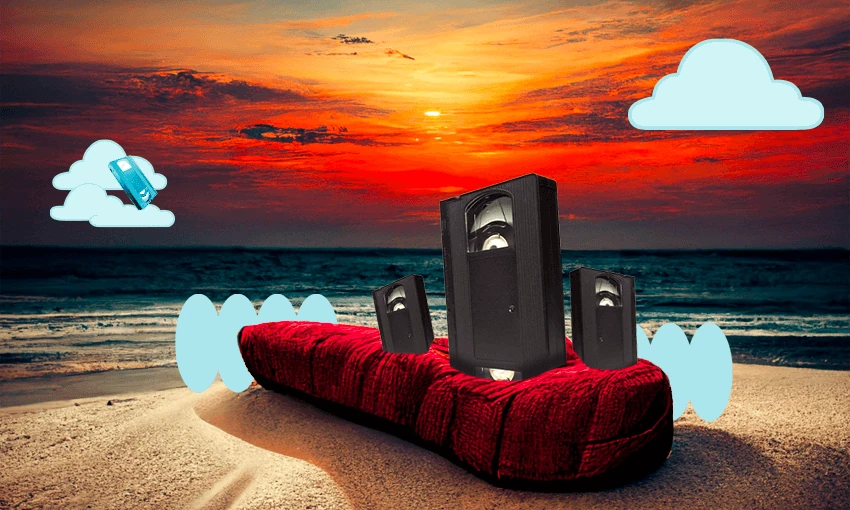The very last of the video stores are falling and to most people those piles of videotapes are just landfill. But some feel like they’re a link to a history worth preserving.
For the last eight years or so, two stories about video stores have been repeated in the media: “Meet the Weirdos Running the Last Video Stores” and “End of an Era as Video Store Closes For Good”.
Andrew Armitage of Wellington’s AroVideo is proposing a different narrative: given that his video library can no longer be feasibly sustained as a commercial business, he’s looking to transfer ownership of the nearly 30,000 titles to an as-yet unidentified trust which would maintain it as a “working archive for the foreseeable future”. He admits, though, that the idea is “complex and has no precedent”. I take great interest in his idea.
A couple of years ago, I wrote and performed a solo theatre show called The Best Show in Town is at Your Place Every Night (first season sponsored by, I am proud to say, AroVideo). The title came from a large sticker on a window of Kilbirnie Amalgamated Video. (Here’s their “end of an era” story). My show used video stores as a metaphor for the things Wellington has seen and lost over the last 40 years or so. Except it wasn’t just a metaphor. It was very specifically about video stores.
Early on in the show I would give an ex-rental videotape to an audience member, telling them it was “a link, a bond. Something which endures. Something real. Something which can be held”. Near the end, I would ask another audience member where a particular tape from a particular store was. The implication was that nobody – in our present – could possibly know. The tape had served its purpose and gone from being something with value to something without value. It was – it is – useless, forgotten, missing.
If I had wanted to make a misty-eyed, as-I-remember sort of a show, I could have reminisced about walking down from my first student flat to the Aro Street Video Shop, which was by then already a Wellington institution. I could have recalled how much those rentals – Superfly, Badlands, Pink Flamingoes, Fritz the Cat, Hated: GG Allin and the Murder Junkies – affected me then, and how the films and the circumstances around my first viewings of them are still churning around in the back of the brain as both personal history and creative mulch.
You can pass an evening talking with great fondness about going to the video shop on a Friday night to choose your five for 10 bucks. But I don’t think it’s enough to look backward, feel a little wistful, mutter “end of an era” and press on any more. We are at a critical juncture. The last remaining commercial video collections are under threat. Netflix has just released a sitcom about a late stage chain video store, and called it Blockbuster. It is a sanitised, warped and untrue sliver of negligible content which will be many people’s first and last exposure to video stores.
In a way, it’s fitting that the Netflix show is so crass and awful. Video stores paved the way for streaming. They are products of the 80s, a decade synonymous with extravagance, poor taste and greed. Home rental made watching movies a private event, in step with the individualism of the times. But there was so much more to the industry than that. The period gave us films shot on video, lurid box cover art, and film commentaries. These are now relics of a defined period of film history.
AroVideo still exists. At the time of writing, you can walk in there and browse the finely curated collection of tapes and discs. It is a part of Wellington’s history and it is worth preserving. Not because we have warm, vague memories of renting tapes from the collection, but because it is a link, a bond. Something which endures. Something real. Something we have a chance to hold on to. If the collection cannot be saved, it will be reduced to “stock” and “assets” to be “liquidated”. It will be dissolved. It will evaporate. The collection is no longer commercially viable. The question is whether or not we believe it has inherent value. Now, says Armitage, “those who care about it need to share the custodianship”.
In my lifetime, it was common for three or four video stores to operate on the same city block. Nobody will ever see this again. A parallel I kept in mind while writing my show was the story of the passenger pigeon. At one time it was the most abundant bird in North America. There are eyewitness accounts of flocks of passenger pigeons blotting out the midday sun. They were hunted to extinction. When they were plentiful, people saw them only as food, and exploited them. If a single one of them were found alive today, its significance would not be that we had recovered a protein source. It would be that we still had a passenger pigeon.
You can pledge support for the preservation of the AroVideo collection here. And you can tell the Ministry for Culture and Heritage that it’s worth saving here.







